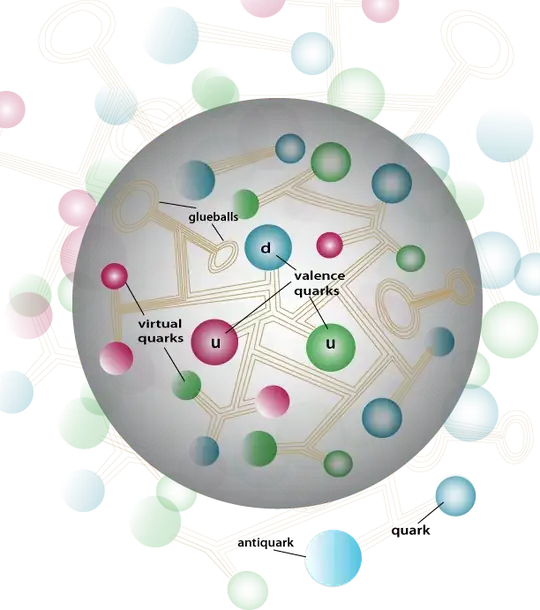Does all the mass of the quarks in the standard model come from the Higgs sector or is there also a contribution to quark masses due to QCD chiral symmetry breaking?
2 Answers
In the standard model the mass for the quarks and other elementary particles comes from from the Higgs mechanism. In the case of the quarks, the masses given in the table of the link are calculated using convoluted theoretical models and data input from scattering experiments.4
At the moment chiral symmetry breaking does not contribute to the quark masses except as it is used in the models fitting for the masses. Chiral symmetry breaking is what binds the quarks in a proton or a pion with a fixed mass.

Protons would fly apart except for the strong nuclear force, which is carried by gluons (force lines between quarks). When gluons clump together they form a “glueball.” Modern conception of the proton includes more than the three “valence” quarks — a down (d) and two up (u) quarks — which account for only about 2 percent of the proton’s mass. The rest comes from a “sea” of virtual quarks and glueballs. Even outside the bounds of the proton, virtual particles spring into and out of existence within the teeming vacuum described by QCD. (Rendering courtesy of Alex Dzierba, Curtis Meyer and Eric Swanson)
All these four vectors including the valence quark four vectors added up and taken into a four dot product give the mass square of the proton, in this example.
With the self interaction strong force terms the valence quarks would be bound, by all this sea, but what defines that the mass of the proton is exactly what is measured, as well as the mass of all the rest of the hadrons?
Here is where chiral symmetry breaking in QCD comes in and its relation to hadronic masses.
The resulting effective theory of baryon bound states of QCD (which describes protons and neutrons), then, has mass terms for these, disallowed by the original linear realization of the chiral symmetry, but allowed by the nonlinear (spontaneously broken) realization thus achieved as a result of the strong interactions.4
Bound states means stable states, resonances.
- 236,935
99.9% of the mass of a hadron or a meson comes from confinement in QCD. Confinement is a special feature of QCD due to its non abelian symmetry which leads to a negative beta function. It is confinement that also leads to a breaking of the chiral symmetry at about 200 MeV or the radius of a hadron (about 1 femto meter).